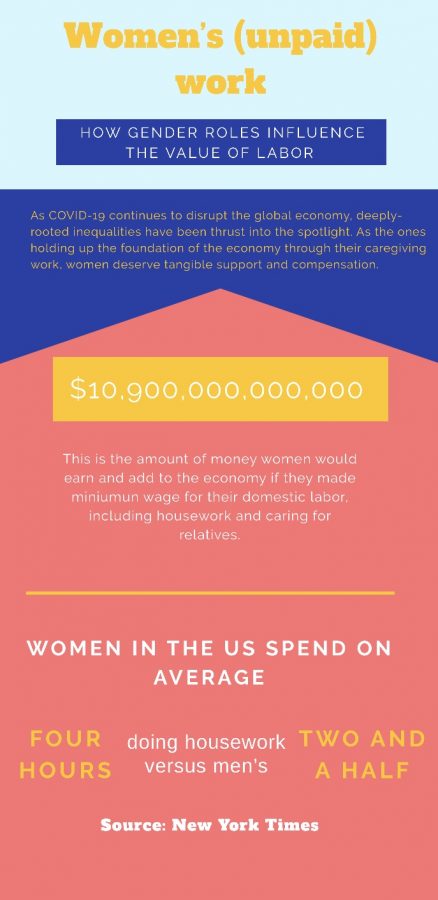Coronavirus is a feminist issue
Gender inequity is being exposed amidst the COVID-19 pandemic
If they were paid for their domestic labor, women would add over ten trillion dollars to the economy. That’s more than the 50 biggest global companies combined.
May 8, 2020
Coronavirus is exposing inequalities among different socioeconomic statuses, including race, class and, although it isn’t as commonly acknowledged, gender. Most of the major federal and state recovery plans, even those that are trying to remedy inequalities among race or class, don’t say a word about achieving gender equity. Because of this, they are doomed to fail.
Women are on the front lines of COVID-19 in every way. They make up 78% of healthcare workers and 91% of registered nurses. More women work in job sectors most affected by stay-at-home orders, such as retail, leisure and hospitality. They are doing much of the essential work in schools, hospitals, nursery homes and grocery stores, yet they are being ignored.
They also do the vast majority of unpaid caregiving work that has become more essential than ever during this time. As the ones most often caring for the young, the elderly and the sick, they are further exposed and at risk. A report from the UN found that on average, women do 2.6 times the amount of unpaid domestic and care work than men. Women are most often the ones in charge of healthcare decisions in the family and are ten times more likely than dads to be the ones staying home with a sick child. They are playing a critical role as caretakers during a global pandemic, with daycares and schools closed, but they aren’t being compensated for it. Until caregiving is built into our economic and social systems rather than resting on the backs of underpaid and unappreciated women, these systems will continue to fail.
The amount of unpaid labor that women do is substantial and it’s fundamental to US economic and social systems. In fact, The New York Times reported that if women were to be paid minimum wage for their housework and caregiving, it would have been worth $1.5 trillion in 2019. Until women’s work is acknowledged, valued and accounted for, there will be no true economic recovery. As the ones providing care for the sick during a health crisis and feeling the most losses during an economic crisis, women will already be left to do much of the work to fix this and deal with its ripple effects which is why recovery plans must specifically address gender equality,
Much like in the home, women’s labor in the workplace is undervalued and underpaid. Even when doing the same job as men, women don’t make the same amount. Unconscious bias and discriminatory practices are factors in the wage gap, as is the motherhood penalty. Women are more likely to leave the workforce to care for young children and sometimes seek lower-paying jobs that will offer them more flexibility to care for children. Closing the wage gap will be a vital piece of recovering from the economic effects of COVID-19.
Because they make up such a large portion of sectors that are suffering major losses during the pandemic, women are enduring the majority of unemployment due to COVID-19. The US Bureau of Labor Statistics reported that women accounted for 60% of jobs lost because of COVID-19. They have outnumbered men in terms of job loss in almost every sector loss during the COVID-19 pandemic. As budgets and jobs are being cut, women tend to be the first fired.
Women also make up a much larger share of “informal workers” who have little job security. Because of this, among other factors, it’s harder for women to bounce back after economic downturns. During the Ebola outbreak, for example, men’s income jumped back to what it was before the outbreak faster than women’s. The disproportionate amount of women becoming unemployed is a signal of an unequal economy, and it is going to impact everyone since women play a critical role in economic recovery.
Not all women are affected equally by the virus or its economic consequences. Black women have faced medical discrimination for decades and are now facing barriers to testing and treatment for coronavirus. In terms of job loss, women of color are particularly at risk and will continue to see disproportionate rates of unemployment because they tend to not have access to solid safety nets and job security. They’re also proportionately more likely to work in at-risk, lower-income jobs like hospitality, food services or custodial services than white women.
Instead of rushing back to normal, states should take this opportunity to evaluate how they can create more resilient and equitable economies. Policies need to be put in place that will shift the balance of caretaking work and address the gender equity issues deeply rooted in the economic system. Paid family and sick leave is a good place to start. Funding public caregiving systems, such as universal childcare and eldercare, has also been successful in shrinking gender inequalities in other countries. One of the most urgent issues to address is domestic violence, which typically spikes during economic downturns, by providing resources and shelter to victims.
Other solutions include infusing safety nets to support single mothers and other caretakers, prioritizing accessible healthcare and passing fair scheduling standards. Ultimately, the major goals of closing the wage gap, redistributing care work and ending job segregation must be addressed by state and local governments.








